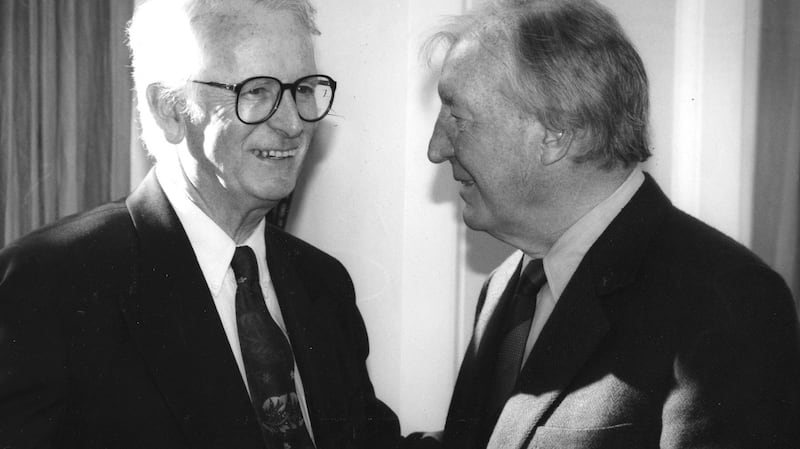Pádraig Ó hUiginn
Born: June 1st, 1924
Died: April 3rd, 2019
Pádraig Ó hUiginn was one of the most influential, dynamic and unorthodox public servants in the history of the State. As secretary general of the Department of the Taoiseach he served three leaders but it was his close relationship with Charles Haughey that allowed him to exercise enormous influence over the direction of the country in the late 1980s.
Ó hUiginn was widely acknowledged as architect of the social partnership that helped the State surmount the economic crisis of the 1980s and he was the driving force behind the development of the International Financial Services Centre (IFSC). After he retired from the civil service, Ó hUiginn launched himself into a private sector career that saw him make a substantial fortune when he was in his 70s.

Ó hUiginn was an erudite man with a deep knowledge of art and a love of languages
His combination of intelligence, guile and charm enabled Ó hUiginn, for a decade or so, to have an influence on public policy that was unmatched by most civil servants in the history of the State. Delivering the eulogy at his funeral, businessman Denis O’Brien captured something of his personality when he described him as “a mixture of Jim Gavin, Joe Schmidt and Bono”.
As well as possessing great political and administrative skills, Ó hUiginn was an erudite man with a deep knowledge of art and a love of languages. One of his party pieces was his own French translation of the anthem of his native Cork, The Banks of My Own Lovely Lee.
Pádraig Ó hUiginn was born in Cork in 1924. He was educated at St Finbarr’s College where he developed an enthusiasm for the Irish language which he maintained all his life. He joined the civil service at the age of 17 as a clerical officer in the Central Statistics Office.
As a young man his enthusiasm for the Irish language prompted his involvement with Craobh na hAiséirghe (Branch of the Resurrection), a militant nationalist and pro-Nazi organisation dedicated to achieving a united Ireland. However, he soon moved in a more mainstream direction, doing a B Com degree by night at UCD and later a Master’s degree in economic and social planning at University of Edinburgh.
He went to work the United Nations in 1956, first to Geneva where he perfected his knowledge of French, and later to New York, where he specialised in spacial planning. He persuaded the Irish government, with the help of a UN grant, to establish a national physical planning institute, An Foras Forbartha, and came back to Ireland as its managing director in 1964.
When Ireland joined the EEC in 1973, he moved to work with the European Council in Brussels. That experience in the Brussels bureaucracy served him well in later years. A casual conversation with then junior minister for finance, Ray MacSharry, after an Ecofin meeting paved the way for his return to Ireland.
He told MacSharry he “wouldn’t mind” coming back to Dublin and in 1979 he ended up as an assistant secretary in the Department of Economic Planning and Development. Haughey abolished the department when he took over as taoiseach in December, 1979 a short time later and merged it with his own department.
He developed a close working relationship with Haughey who quickly came to appreciate his skills as somebody who could get things done. He was involved at the taoiseach’s request in settling a number of potential public service pay disputes with teachers, nurses and gardaí.
There was some criticism of the substantial pay rises which ensued but it was the Talbot deal, which guaranteed redundant car assembly workers their pay packets for life, which drew sustained criticism from opposition politicians and economic commentators.
Haughey promoted Ó hUiginn to secretary general of the department in June 1982. During the life of the crisis that beset the Fianna Fáil government of 1982, he developed the concept of a Programme for National Recovery involving consultation with trade unions, employers and farmers. The government collapsed before it could be developed but the plan was incorporated into the Fianna Fáil election manifesto “The Way Forward” for the snap general election of November, 1982.
Over the following five years Ó hUiginn was marginalised by Garret FitzGerald because of his closeness to Haughey. “He nearly died of boredom,” said one official at the time. As the government struggled to get the country out of a deep economic crisis, Ó hUiginn worked with the National Economic and Social Council on a report which incorporated his ideas.
Even though he is a civil servant, he has an instinctive grasp of the politics of any given situation and that's why he gets on so well with Haughey
This report formed the basis for social partnership when Haughey returned to power in 1987. It played a crucial role in getting the country on to the path of sustained economic growth which created the modern Irish economy. For the following five years, Ó hUiginn was at the height of his power and influence. On Haughey’s instructions he worked with Dermot Desmond to establish the IFSC.
“The key to Ó hUiginn’s influence is that he is psychologically attuned to Charlie’s mode of operation. Even though he is a civil servant, he has an instinctive grasp of the politics of any given situation and that’s why he gets on so well with Haughey,” said a senior trade unionist at the time.
“In the beginning we were astonished at Ó hUiginn’s style of negotiation. We discovered that he didn’t give a damn for official departmental policy, he simply wanted to find solutions to problems and we often found him siding with us against the other civil servants, particularly those from finance.”
It was this ability to go straight for solutions which led to his reputation as a fixer par excellence. Ministers in Haughey’s government quickly came to realise that getting Ó hUiginn’s approval for their plans was an essential prerequisite.
One of his tactics when issuing instructions was to say: “The taoiseach wants this done.” A senior civil servant in another department was convinced this was simply a ruse and decided to ignore a request from Ó hUiginn. When his minister was savaged by Haughey at the next cabinet meeting, he realised that if Ó hUiginn wanted something done, it carried the same weight as a direct instruction from the taoiseach.
Ó hUiginn had his critics and there was a great deal of suspicion about him in the senior ranks of the civil service, particularly in finance where some officials believed his talents as a fixer sometimes took too little account of the state of the national finances.
His closeness to Haughey led to criticism in the Beef Tribunal report and eyebrows were raised when it became public knowledge that he attended meetings in Haughey’s Kinsealy home along with Bertie Ahern and P.J. Mara during the various political crises that beset the government.
When he reached the statutory retirement age of 65 in 1989 Haughey gave him a three-year extension. This provoked some resentful comment in the civil service as he had been involved in devising an early retirement scheme for public servants to save money for the exchequer.
He took out his chequebook and wrote a large cheque to buy shares. I was stumped because I told him there were huge risks in buying shares
He retired not long after Reynolds became taoiseach and embarked on a new career in business. Denis O’Brien invited him to become a director of Esat Telecom which at that stage was a small company with ambitions to win a mobile phone licence.
“He said he would love to, took out his chequebook and wrote a large cheque to buy shares. I was stumped because I told him there were huge risks in buying shares and I tried to talk him out of it.”
Five years later Ó hUiginn made €4 million when Esat was taken over by British Telecom. In the meantime he had played a critically important role in ensuring that the company won the competition for the second mobile phone licence.
His advice to O’Brien on how to draw up the bid is widely regarded as the critical factor in ensuring that Esat won the licence. It is no accident that a plaque on the wall of Aercap, the new office block developed by O’Brien on the corner of Stephen’s Green, commemorates Ó hUiginn and his contribution to Irish life.
A director of the Irish Museum of Modern Art and a keen collector, he was also an avid golfer. As a director of Bord Fáilte in the 1990s, he worked with then minister for tourism Enda Kenny to bring the Ryder Cup to Ireland.
He maintained his interest in current affairs to the end and his son Ciaran told mourners at the funeral that he simply loved the Irish Times. He is survived by his wife, Patricia, and children Mairin, Peadar, Ciaran and Feargal.














